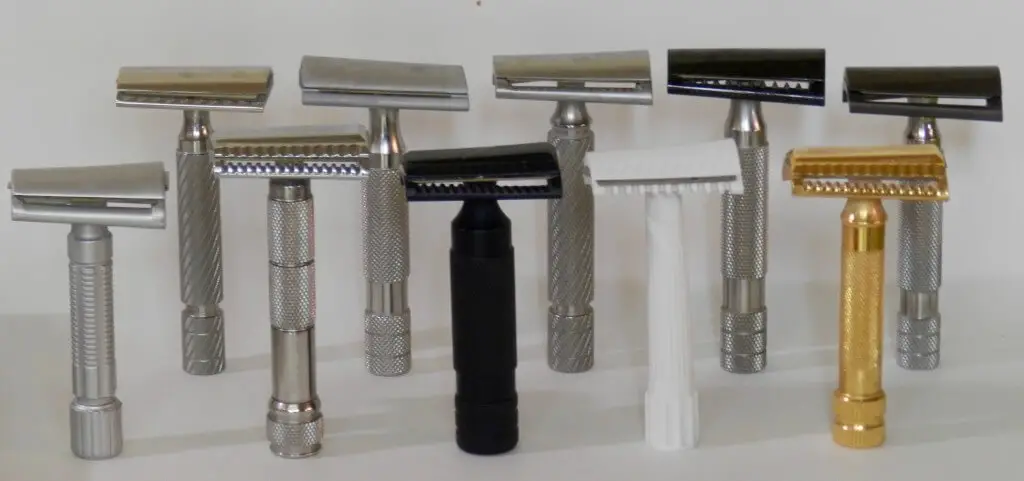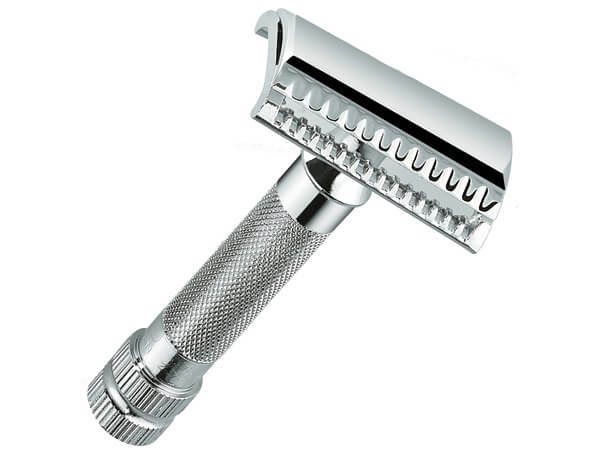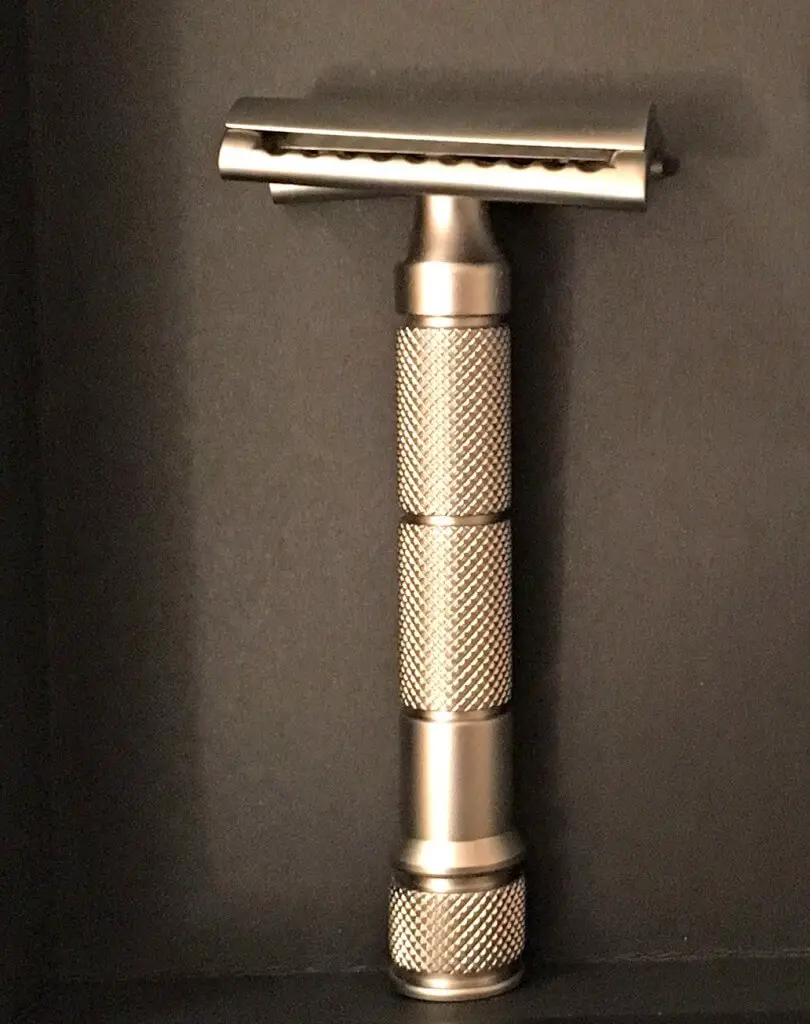
[Introduction by “Mantic59”] “Slant bar” razors have enjoyed a renewed popularity in the wet shaving world lately. But there seems to be a fair amount of disagreement behind both the technology and the performance of these razors. So I brought together some experienced shavers who have some strong opinions about the “slant” for a discussion of the what’s, the why’s and the how’s. These “panelists” included mainly Michael “Leisureguy” Ham, Victor Marks, and Craig Kelleher…along with some minor comments and kibitzing from myself and Joe Borrelli.
The discussion was robust and covered the course of several months. Then they came together to write this summary:
The Efficacy Of Slant Bar Razors
Slants are very popular currently, and a substantial proportion of those who try them find that for them the slant gives a better shave. The exact reasons for this perception are controversial (the reason why it is claimed is clear—that’s their experience; it’s the reason for the experience that’s controversial).
Many users report better shaves with slants as compared to conventional DE razors; in particular a closer, more efficient shave without irritation. Virtually no respondents claim a slant gave them a worse shave. The other users informally surveyed found the slant shaved about as well as a conventional design.
Is the perceived strength of slants due to a specific benefit of the slanted blade, or due to a better head design in terms of exposure and angle of blade without the slanted aspect having any real effect? Or could this perception even be due to the placebo effect, where those using slants expect a better result and end up with a self-fulfilling prophecy? Or might the somewhat fearsome appearance of the slant induce unconscious alterations in technique, such as using lighter pressure and being more careful about blade angle? Some modern research we found shows that the force required to cut is reduced as the degree of slant is increased, up until about 11 degrees, after which the reduction in force remains pretty consistently the same.
The Heart Of The Controversy
The heart of the controversy about the effectiveness of slants is that the precise mechanical reason for this alleged success is elusive. The original Merkur slant design was patented in an era where one could make relatively mushy scientific claims about the function of the patented device, and some hard-eyed modern observers say the Merkur slant concept is one such imprecise and unverified set of claims.
Slant cynics claim that any well-designed conventional head (with a bar guard or comb guard) can give a better shave than those offered by the mild bar-guard designs with which most wet shavers begin their odyssey, and that the slant has no special magic, just a more efficient combination of blade exposure and angle than something like the Merkur 34C or Jagger DE89 series.
It is difficult for slant fans and skeptics to agree on a common basis of evaluation. The fans point to user experience, as measured by social science styles of proof like surveys, while the skeptics want testing of slants versus non-slants where both models tested would use similar combinations of exposure and cutting angle, with one head slanted and the other conventionally placed. This would require custom designed or modified heads, which do not currently exist. Someone with machining experience might be able to make this happen in the future, but for now, the sides agree to disagree on whether and why slants work in mechanical terms.
The slant makers offer little help in this debate, stating only that they are making slants because people want to buy them. The retro popularity of some vintage designs (e.g. the Bakelite Slant), the aesthetic appeal of those weirdly curved plates, and the need of bored wet shavers for more variety and adventure in their daily routines may account for the popularity of slants as much as any inherent mechanical design feature. No slant maker polled could give a coherent mechanics-based explanation of why their designs worked better than conventional ones.
One Recommendation
Our panelists fortunately are united in recommending a slant design for those wishing to try the concept. The Ikon X3 aluminum alloy slant head is praised by all panelists to varying degrees (EDITOR’S NOTE sample purchase links: Maggard, Italian Barber, Amazon*). Its fans cite a smooth face feel, high efficiency, and relative affordability; use of an Ikon handle with the head is not deemed necessary. The Ikon 102 head (also an aluminum alloy) is favored by panelists who have used it as well, and this is a different design in which the head is tilted rather than the blade being twisted, which latter feature is more common in slant heads. The problem with recommending the Ikon heads (both roughly $35 list) is that availability is occasionally sparse from both the maker and his retail partners, dependent on demand and production schedule.
Other Options
If you cannot get the Ikon heads, or want to save a few dollars, the RazoRock German 37 head is both in stock and inexpensive ($12) The elder statesmen of the slant world, the Merkur Merkur 37* & 39*, are viewed as an acceptable substitute, but they are neither as efficient as the primary choices, nor as affordable as the RazoRock, which matches the Merkurs in feel and performance at a fraction of their cost. The Holy Black SR-71 slant is another Merkur slant clone and costs somewhat less than the Merkur models.
Other modern production slants generated even less enthusiasm among the panelist consensus and so should probably be avoided as first choices. There are other non-slant modern production designs available for those seeking variety or greater efficiency, including the Maggard V3A head, the Ikon 101, the RazoRock Old Type open comb, the Rockwell 6S, the Standard, the Dorco PL602, etc.
In the normal world of wet shaving discourse, if one says, for example, the Jagger DE89 shaves him better than the Merkur 34c, there is no argument; “YMMV” is the usual explanation, based on the observable fact that men vary a lot in the nature of their beards (which range from tough, thick, and coarse to fine, sparse, and downy) and skin (from super sensitive to tough as leather) and technique (from the typical novice errors to practiced expertise) and their prep (hard water v. soft water, to mention only one variable), and so on. Because men vary, the same razor or the same blade may work differently for different men.
Slants seem to arouse a bit more passion among experienced wet shavers, perhaps because of the occasionally broad scope alleged as to their absolute efficacy. There seems to be no doubt that many wet shavers with a bit of experience view a slant as a logical next step, and also no doubt that roughly one out of every two of these explorers seems to feel the slant experiment was a worthwhile one. Other paths of exploration might also benefit these sojourners (open combs, more efficient straight bar combs) and it is to be hoped that slant experimenters will also try other designs to see if the slant is really the best of all possible shaving worlds for their personal needs.
Panelists shared the opinion that something like the Ikon 102 could be a good first razor, mitigating the myth that slants can only be used by experienced DE shavers. The traditional admonition against pressure is still very valid though, so those who are using a slant as their starter razor must be careful to be light-handed.
Who should use a slant? Daily shavers or several times a week shavers. Those with tough, coarse beards. Shavers looking for more efficiency in their shaves. More controversially, those with sensitive skin may find a slant offers efficiency without irritation, but again we are bumping up against the issue of efficiency and how the slant achieves that if we are going to postulate “cuts great, irritates less”.
All panelists agree that the “slants need light handles” concept is flawed. Even plastic Bakelite clones fared better with panelists when the lightweight head was attached to a heavier metal handle rather than the plastic light handles the Bakelite type came with. The weight creates an impression of greater precision and control in use, even though added pressure is not needed.
Technique?
The Gillette Slide can replace the need for a slant on some areas of the face when used competently with a conventionally designed head. That same technique can also be used with a slant as well, giving one a “super guillotine” effect (and / or massive facial trauma, dependent on user skill). The great advantage of the slant is that it can approximate a “slide” effect all over one’s face, even with a fairly moderate skill base and without learning a new technique.
One of our panelists urged razor makers to be more experimental and creative in slant designs, and feels a blade cutting angle of greater than an 11 degree tilt would give optimal results, without any torqueing of the blade itself being required. (A sort of “Super Ikon 102” effect). Most modern slants appear to have heads with only 4 or 5 degrees of tilt to the head. There are numerous vintage designs that offered this concept, and it would be both refreshing and possibly transformative to see some modern remakes of these designs versus endless iterations of the torqued blade models of yesteryear, mainly the Bakelite and Mulcuto.

That same panelist opined that the Merkur 37C and its imitators potentially offer a worse shave than a conventional straight bar design, as the uneven blade exposure relative to the safety bar in many cases means part of the head is cutting while the other side is scraping. With a torqued blade, it is pretty much impossible to get a consistent cutting effect across the entire blade at the same time. In this sense, a successful torqued blade design is succeeding despite its geometry rather than because of such.
A slant does not need to use the costliest blade in the repertoire. A less costly blade like a Derby could work very well and give very efficient shaves for not much money, probably to a greater extent that that same blade might when used in a conventional bar guard head. Shavers are urged to experiment with different blades when trying a slant, as even a blade that works for them very well in other razors may be bested by another brand when used in a slant.
At the end of the day, it is apparent that wet shavers are growing in number, along with an already “installed” sizable user base that is not abandoning the hobby. The quest for efficiency and / or new experiences has led many to slants and this well-trodden path will probably remain popular for the foreseeable future, regardless of an objective empirical basis for slant’s efficacy.
*affiliate link
Related posts:
The Maggard Slant Razor
The Mr. Fine Superlite Slant
What’s Up With Slant Bar Razors?
Did you find this article interesting? Please share it!


I began to think how a slant might work. I can see 2 things. I am not a technician, so this is food for discussion at best.
1) A 6 degree slant will use roughly 1% more cutting edge length to shave a certain width of stubble, than a regular razor. A 1% more cutting edge doesn’t seem that much.
2) Because the blade is at an angle it will not only push a hair straight down but also to the side. Therefore the hair will come into contact with another area of the blade creating a slice cut using more of the edge. A regular razor normally only pushes the hair straight down and therefore hacks or hews the hair with a smaller part of the edge. At a 6% degree angle I wouldn’t expect that this would have a huge impact.
Maybe the effects (if existing at all) of 1) and 2) reinforce each other?
Great article. I appreciate the skeptical approach to the concept. I just received an X3 and I hope it gives a great, efficient and mild shave. I’ll see….
Good photo above the post, but there is no Wunderbar slant. It is very effective!
Wunderbar review coming soon!
Good news. Waiting for it!
What is the difference between a slant razor, and shaving with your DE but using it at a slanted angle. Wouldn’t that produce the same effect? Is there some special design feature with the slant that makes the difference? I use my DE at a slanted angle quite often. My impression is, that it would cause the hair to be sliced rather than chopped.
This discussion has now got me very ‘slant’ curious.
I have to confess that I don’t agree at all with the opinion that the Ikon X3 is a highly efficient razor. To me (and to other bloggers and YouTube shavers) the X3 is less efficient than the Maggart slant and certainly less efficient than the Merkur 37C/39C. The other issue is that the X3 has a narrow cutting angle that makes it not so intuitive to use. Smooth… yes, efficient… not so much.
YMMV applies to razors as well as (say) soaps and brushes. For me and for many, the X3 is extremely efficient. It leaves most of my face BBS after the second pass, though I do a third pass for the areas not yet BBS (chin, upper lip, part of neck). At the finish, though, I cannot feel any roughness in any direction.
The X3 is not the only razor that achieves this, of course, but it achieves it more comfortably and more easily than almost any. (For me, the 102 is closely matched, and the Above the Time S1 is about as good (and costs $146 for the head vs. $35 for the X3 head).
Our suggestion was to give it a try and decide based on one’s own experience, since that can differ from the experience of someone else, just as our experience with the X3 differs.
It may be that the inefficiency that you detect is in part due to the difficulty you mention in finding and maintaining the optimal cutting angle.
Like Larry, I tried a slant after many years of DE shaving. My first was the Merkur, which changed my opinion. Now I have 2 Razor Rock Slants, the ATT S1 and S2, as well as the Merkur. I find that slants give me the best shaves.
Like Larry, above, I tried a slant after many years of DE shaving. My first was the Merkur, which changed my opinion. Now I have 2 Razor Rock Slants, the ATT S1 and S2, as well as the Merkur. I find that slants give me the best shaves.
Great review. I didn’t buy into the slant hype until I tried one. I have 4 now and use them all.
Comments are closed.